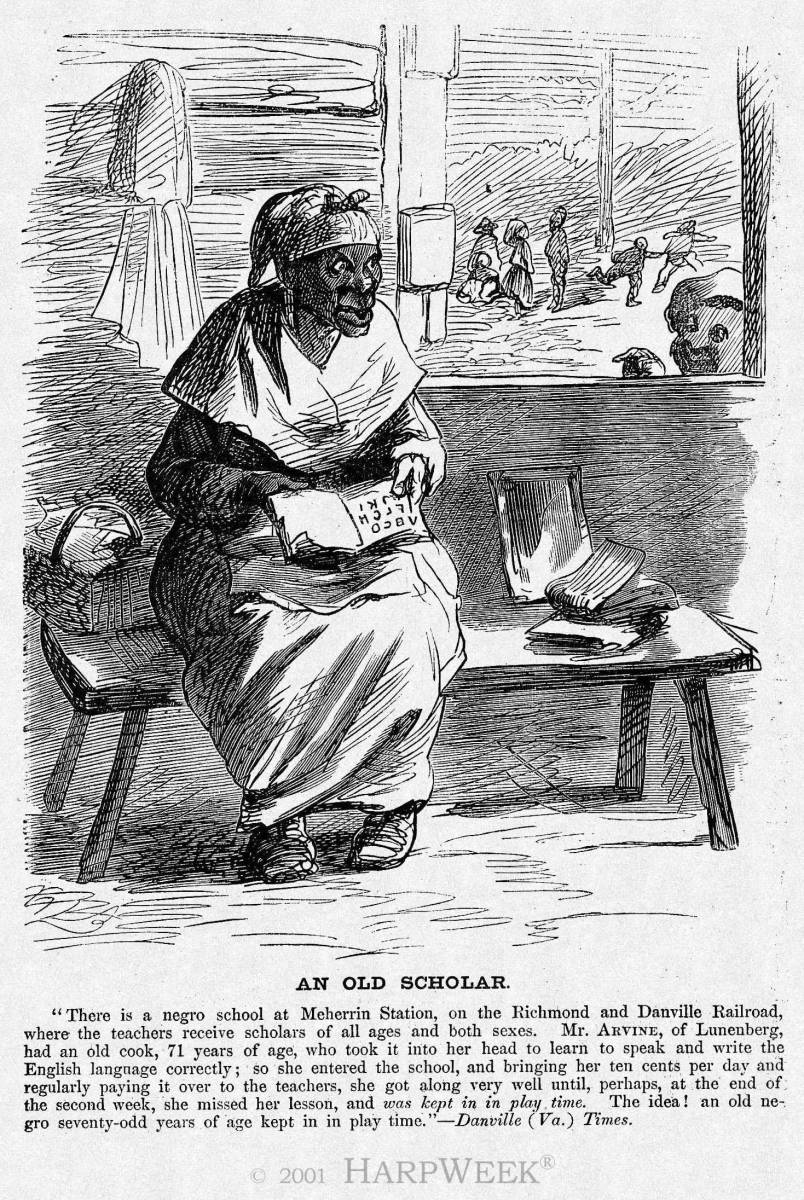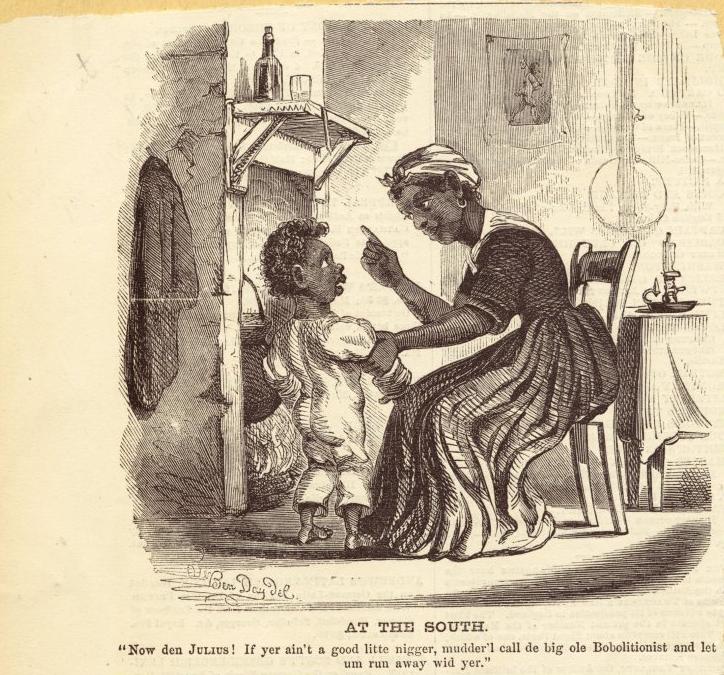
"There is a negro school at Meherrin Station, on the Richmond and Danville Railroad, where the teachers receive scholars of all ages and bot sexes. Mr. Arvine, of Luneuberg, had an old cook, 71 years of age, who took it into her head to learn to speak and write the English language correctly; so she entered the school, and bringing her ten cents per day and regularly paying it over to the teachers, she got along very well until, perhaps, at the end of the second week, she missed her lessons, and was kept in in play time. The idea! and old negro seventy-odd years of age kept in in playtime." Danville, Virginia Times.

Complete Harp Week Explanation:
The basis of the joke in this cartoon is the incongruity of an elderly person as an elementary school student and, even more, one kept inside at recess. Underneath the humor, though, is the disheartening fact that an entire segment of the American population— former slaves—had previously been prohibited from acquiring even a rudimentary education. Yet this cartoon points to the great yearning for formal knowledge that pervaded all age groups among the freedmen, and to the hope they invested in education. In Union-occupied Louisiana in 1863, a Northern missionary observed that the former slaves were "every one pleading to be taught, willing to do anything for learning." A South Carolina freedman exclaimed to his teacher, "My Lord, ma'am, what a great thing learning is!" In 1869, a black Mississippian declared that if he never did anything else in his life, giving his children a chance to go to school was "the next best thing to liberty."
During the Civil War, Northern abolitionists began establishing organizations to assist emancipated slaves in adjusting to their new situation. A key aspect of this process was the education of the mostly illiterate freedmen. Many of the freedmen's societies were affiliated with Protestant denominations, the largest of which was the American Missionary Association of the Congregational Church. Secular associations, such as the New England Freedmen's Aid Society, and philanthropies, like the Peabody Fund, also played a role. In September 1861, Mary Peake, a free black, founded the first freedmen's school at Fort Monroe in Hampton, Virginia. Of the 4000 volunteers who taught in Southern freedmen's schools during the 1860s, most were white (80%), female (75%), and born in New England (60%). The proportion of Northern white teachers fell over the decade, so that by 1870 half the teachers were black. Southern blacks, led by the African Methodist Episcopal Church, also established, financed, and administered their own schools.

In March 1865, Congress created a temporary federal agency, nicknamed the Freedmen's Bureau, to provides relief to the emancipated slaves in the form of basic shelter and medical care, assistance in labor-contract negotiation, and similar services. Among the latter, the public agency worked with private freedmen's societies (31 religious and 20 secular) to run the freedmen's schools. The Freedmen's Bureau allocated one-third of its budget to education, providing school buildings, transportation for teachers, and basic oversight, while the societies hired and paid the teachers and set the curriculum and content. About $9 million was spent on freedmen's education from 1865-1870, with $5 million provided by the Freedmen's Bureau, $3 million by the Northern associations, and $1 million by American blacks. By 1870, there were 4000 such schools serving over 200,000 students and employing about 9,000 teachers.
Many Southern whites, though, resented the idea of educating blacks, fearing that it would undermine the notion of white supremacy. Freedmen's schools and teachers were a frequent target of violence during the Reconstruction Era. Images of both the torching of freedmen's schools and the freedmen's school as a cultural icon can be seen in the Harper's Weekly cartoons of Thomas Nast. Despite inroads made by the freedmen's schools, only 12% of Southern black children were enrolled in school in 1870 (and only a slightly higher percentage of white school-age children in the South).

The public school system was also inaugurated in the South during Reconstruction, but its effectiveness was undercut by limited funds, teacher shortages, and the expense of segregated schools, corruption, and other problems. By 1876, the number of Southern children enrolled in school (public, private, or mixed) had risen to 50% for whites and 40% for blacks. As public schools opened across the South, the secular freedmen's societies transferred their schools and property to the state systems. The religious-affiliated freedmen's associations turned over their lower schools to the states, but kept their secondary schools. Some of the latter evolved into important institutions of higher learning for black Americans, including Fisk University, Atlanta University, Morehouse College, and Spelman College.
The 1880 census revealed that millions of black and white Southerners were still illiterate, a shocking statistic that revived a movement for the federal funding of education. Senator Henry W. Blair of New Hampshire, a Republican, sponsored legislation to allocate $15 million annually to the states, divided proportionally according to their illiteracy rates. This meant that the bulk of the $77 million over 18 years would go to the South. Prominent Americans, including Chief Justice Morrison Waite of the U.S. Supreme Court, urged the policy as socially necessary and constitutionally acceptable. The Republican Party endorsed the proposal in its platform. The Blair Bill passed the Republican-controlled Senate three times during the 1880s, but Speaker John Carlisle of Kentucky never allowed the bill to reach the floor of the Democratically-controlled House. (source: Harpers Weekly)

Complete Harp Week Explanation:
The basis of the joke in this cartoon is the incongruity of an elderly person as an elementary school student and, even more, one kept inside at recess. Underneath the humor, though, is the disheartening fact that an entire segment of the American population— former slaves—had previously been prohibited from acquiring even a rudimentary education. Yet this cartoon points to the great yearning for formal knowledge that pervaded all age groups among the freedmen, and to the hope they invested in education. In Union-occupied Louisiana in 1863, a Northern missionary observed that the former slaves were "every one pleading to be taught, willing to do anything for learning." A South Carolina freedman exclaimed to his teacher, "My Lord, ma'am, what a great thing learning is!" In 1869, a black Mississippian declared that if he never did anything else in his life, giving his children a chance to go to school was "the next best thing to liberty."
During the Civil War, Northern abolitionists began establishing organizations to assist emancipated slaves in adjusting to their new situation. A key aspect of this process was the education of the mostly illiterate freedmen. Many of the freedmen's societies were affiliated with Protestant denominations, the largest of which was the American Missionary Association of the Congregational Church. Secular associations, such as the New England Freedmen's Aid Society, and philanthropies, like the Peabody Fund, also played a role. In September 1861, Mary Peake, a free black, founded the first freedmen's school at Fort Monroe in Hampton, Virginia. Of the 4000 volunteers who taught in Southern freedmen's schools during the 1860s, most were white (80%), female (75%), and born in New England (60%). The proportion of Northern white teachers fell over the decade, so that by 1870 half the teachers were black. Southern blacks, led by the African Methodist Episcopal Church, also established, financed, and administered their own schools.

In March 1865, Congress created a temporary federal agency, nicknamed the Freedmen's Bureau, to provides relief to the emancipated slaves in the form of basic shelter and medical care, assistance in labor-contract negotiation, and similar services. Among the latter, the public agency worked with private freedmen's societies (31 religious and 20 secular) to run the freedmen's schools. The Freedmen's Bureau allocated one-third of its budget to education, providing school buildings, transportation for teachers, and basic oversight, while the societies hired and paid the teachers and set the curriculum and content. About $9 million was spent on freedmen's education from 1865-1870, with $5 million provided by the Freedmen's Bureau, $3 million by the Northern associations, and $1 million by American blacks. By 1870, there were 4000 such schools serving over 200,000 students and employing about 9,000 teachers.
Many Southern whites, though, resented the idea of educating blacks, fearing that it would undermine the notion of white supremacy. Freedmen's schools and teachers were a frequent target of violence during the Reconstruction Era. Images of both the torching of freedmen's schools and the freedmen's school as a cultural icon can be seen in the Harper's Weekly cartoons of Thomas Nast. Despite inroads made by the freedmen's schools, only 12% of Southern black children were enrolled in school in 1870 (and only a slightly higher percentage of white school-age children in the South).

The public school system was also inaugurated in the South during Reconstruction, but its effectiveness was undercut by limited funds, teacher shortages, and the expense of segregated schools, corruption, and other problems. By 1876, the number of Southern children enrolled in school (public, private, or mixed) had risen to 50% for whites and 40% for blacks. As public schools opened across the South, the secular freedmen's societies transferred their schools and property to the state systems. The religious-affiliated freedmen's associations turned over their lower schools to the states, but kept their secondary schools. Some of the latter evolved into important institutions of higher learning for black Americans, including Fisk University, Atlanta University, Morehouse College, and Spelman College.
The 1880 census revealed that millions of black and white Southerners were still illiterate, a shocking statistic that revived a movement for the federal funding of education. Senator Henry W. Blair of New Hampshire, a Republican, sponsored legislation to allocate $15 million annually to the states, divided proportionally according to their illiteracy rates. This meant that the bulk of the $77 million over 18 years would go to the South. Prominent Americans, including Chief Justice Morrison Waite of the U.S. Supreme Court, urged the policy as socially necessary and constitutionally acceptable. The Republican Party endorsed the proposal in its platform. The Blair Bill passed the Republican-controlled Senate three times during the 1880s, but Speaker John Carlisle of Kentucky never allowed the bill to reach the floor of the Democratically-controlled House. (source: Harpers Weekly)
No comments:
Post a Comment